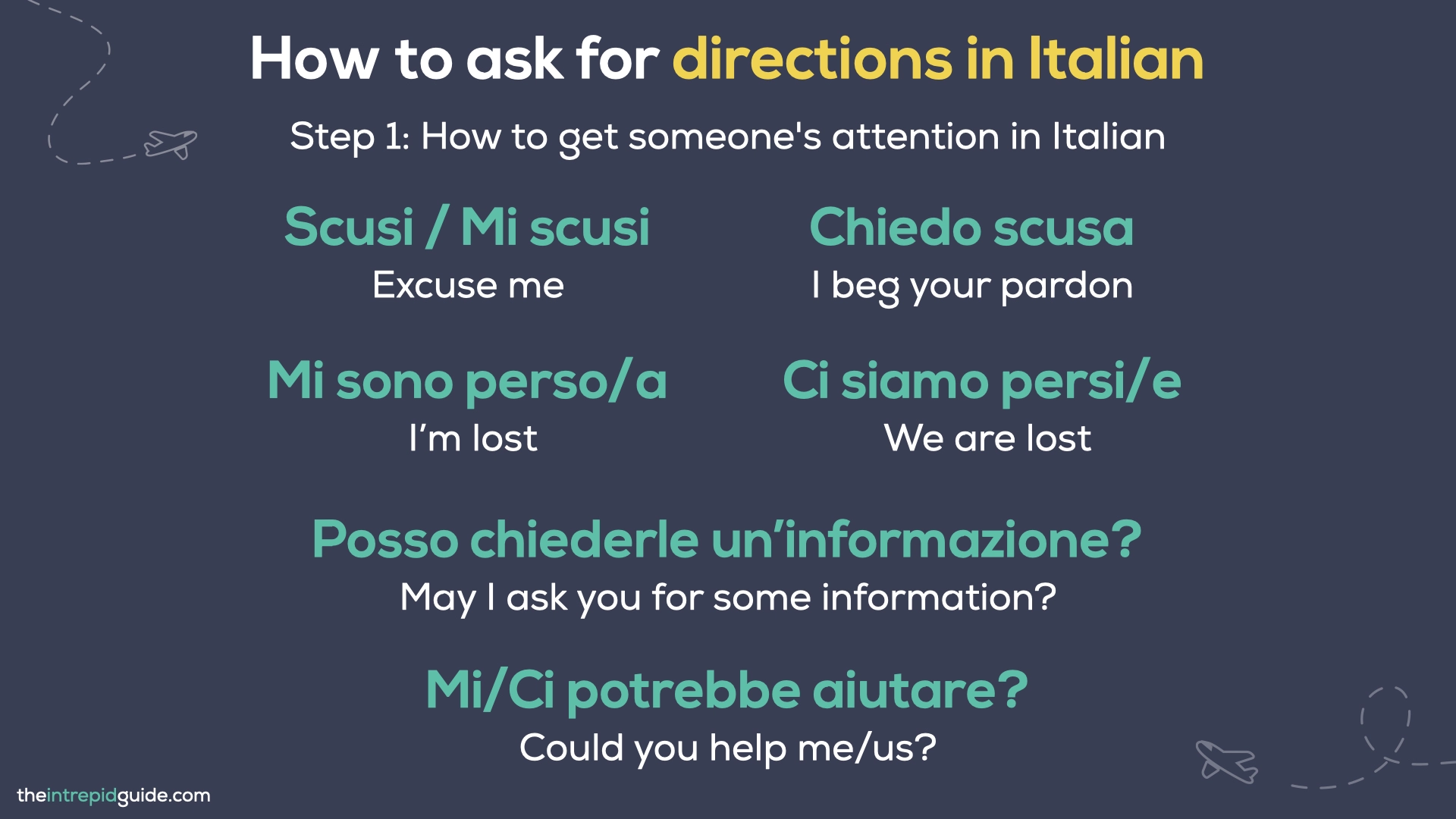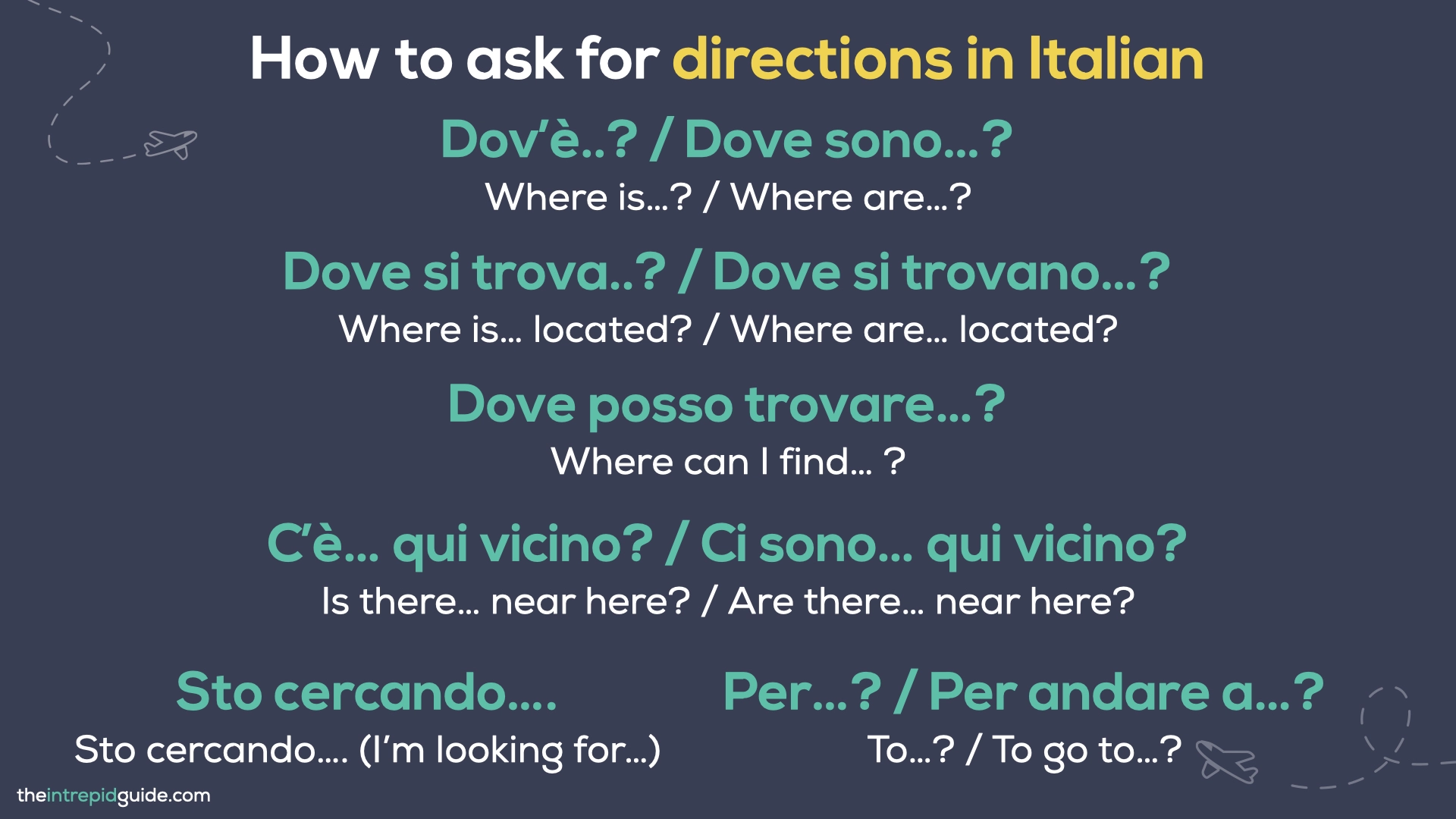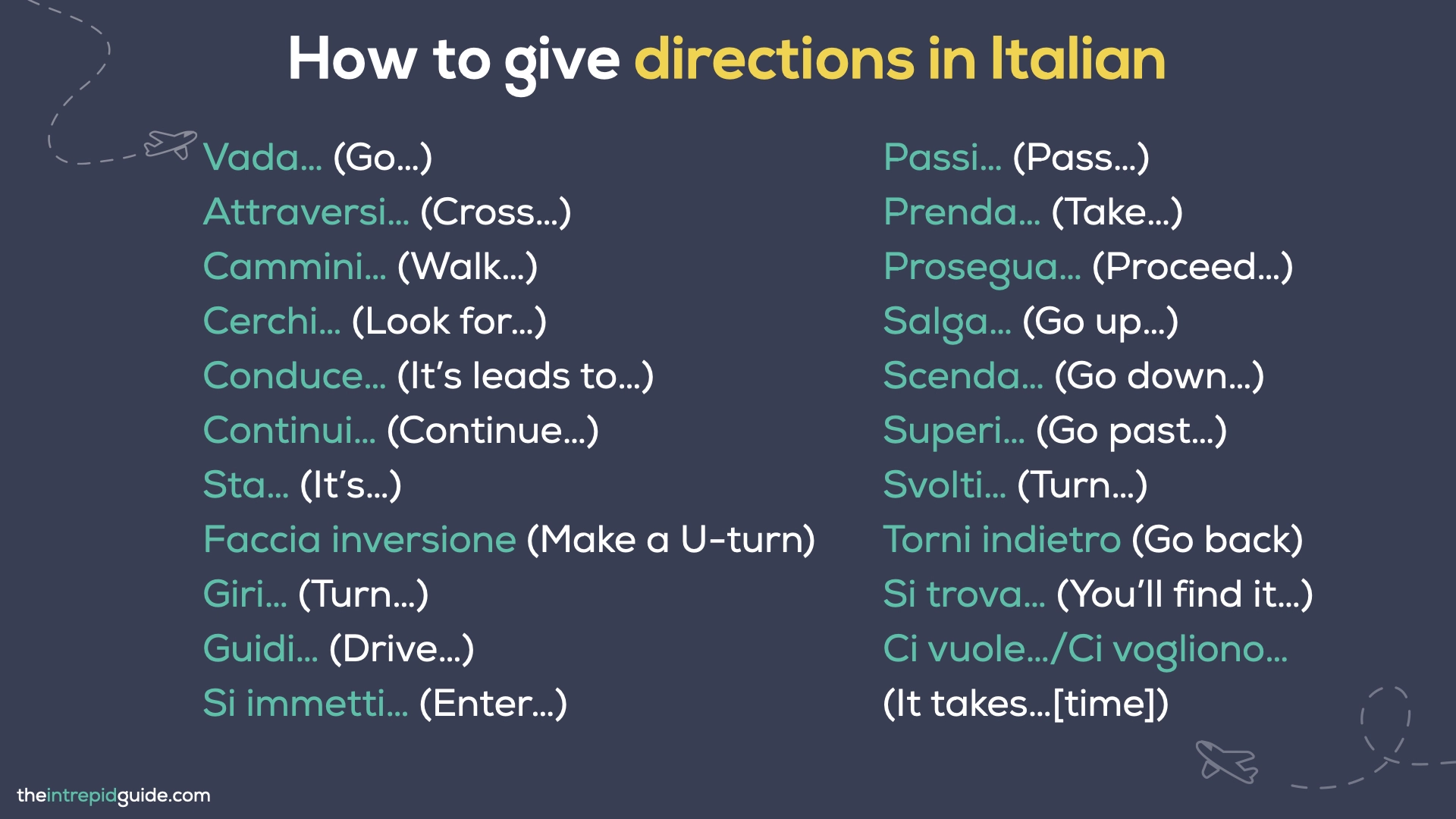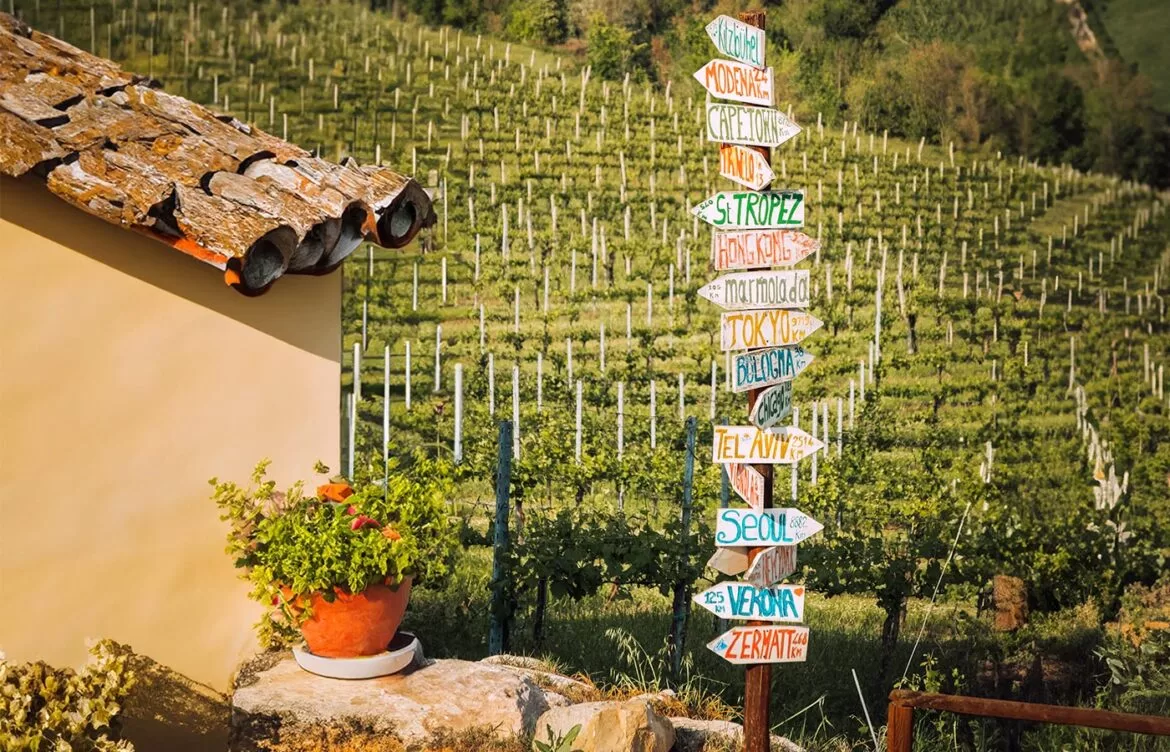Are you tired of feeling like a lost tourist, desperately scrolling through guides and Google Maps, only to end up more confused than ever? The frustration peaks especially when hunger strikes and you’re unable to locate that perfect little trattoria you’ve been dreaming about since hitting the “book flight” button. Trust me, we’ve all been there!
In moments like these, mastering the art of asking for and giving directions in Italian can be a game-changer. Not only does it prove invaluable when technology fails you, but it’s also a fantastic way to strike up conversations with locals and truly immerse yourself in the culture.
In this guide, I break down all the must-know Italian phrases, words, and verbs you need so you can confidently ask where things are and understand directions, effortlessly navigating streets, and discovering hidden gems that no app could ever lead you to. I’ve also included a fun quiz at the end to test how much you’ve learned!
So, grab your imaginary gelato, throw on those virtual shades, and let’s embark on this language adventure! But first, make sure to download your free PDF cheat-sheet, which includes all the key points we’ll cover in this guide. Just enter your email below and I’ll send it to you straight away.
Table to Contents
Here’s what we’ll cover in this guide. Click on any title to jump to each section.
- How to ask for directions in Italian
- How to give directions in Italian
- Useful Italian expressions for when you’re unsure
- Take the quiz!
How to ask for directions in Italian

Being able to seek assistance when you find yourself a little disoriented is a crucial aspect of mastering Italian for travel. Instead of resorting to frantic hand gestures and pointing at maps, incorporating a few Italian phrases into your inquiries will swiftly open up the warmth and hospitality of the locals. And before you know it, you’ll be swapping stories, taking down notes, and, who knows, maybe even enjoy an espresso together!
To simplify the process, I’ve organized the essentials of asking for directions in Italian into sections, each accompanied by real-life examples.
Step 1: How to get someone’s attention in Italian
Your approach sets the tone for any interaction. Starting things off with a polite Italian greeting like Scusi / Mi scusi (Excuse me) or Chiedo scusa (I beg your pardon) is a great way to grab someone’s attention.
If you’re keeping it casual, especially with a younger audience, you can just go with the informal Scusa / Scusami (Excuse me). And remember, Italians love their hand gestures, so a raised finger or a graceful hand wave can say a lot before you even speak!
Now, you can candidly confess you’re lost by saying:
- Mi sono perso/a (I’m lost)
- Ci siamo persi/e (We are lost).
If you prefer to play it cool, you can go with:
- Posso chiederle un’informazione? (May I ask you for some information?)
- Mi/Ci potrebbe aiutare? (Could you help me/us?).
For a more informal tone:
- Posso chiederti un’informazione? (Can I ask you for some information?)
- Mi/Ci potresti aiutare? (Could you help me/us?) will do the trick.
Here are some examples:
- Scusi, mi sono perso! Posso chiederle un’informazione? – Excuse me, I’m lost! May I ask you for some information?
- Chiedo scusa, ci potrebbe aiutare? – I beg your pardon, could you help us?
- Scusa, posso chiederti un’informazione? – Excuse me, can I ask you for some information?
- Scusami, ci siamo persi. Ci potresti aiutare? – Excuse me, we are lost. Could you help us?
Now that you’ve successfully captured the other person’s attention, let’s explore how to ask for directions effectively. Remember, a warm smile and polite manner can work wonders, so be sure to include a friendly per favore (please) either before or after your question.
Step 2. How to ask where something is in Italian

Dov’è..? / Dove sono…? (Where is…? / Where are…?)
These are the most basic phrases for asking directions in Italian. Their construction is super simple, beginning with Dove (Where), followed by the verb essere (to be), conjugated either in the third person singular (è – is) or plural (sono – are) depending on the noun that follows. Here are some examples:
- Dov’è il Duomo? – Where is the Cathedral?
- Dove sono i bagni pubblici? – Where are the public restrooms?
Dove si trova..? / Dove si trovano…? (Where is… located? / Where are… located?)
This is another common expression for seeking directions in Italy. The structure and meaning are similar to the previous expression, with the verb trovarsi (to be located) replacing essere (to be). Here are some examples:
- Dove si trova il Teatro Ariston? – Where is the Ariston Theater located?
- Dove si trovano gli uffici comunali? – Where are the municipal offices located?
Dove posso trovare…? (Where can I find… ?)
This expression is slightly more formal and typically used when seeking recommendations. Here are some examples:
- Dove posso trovare un buon ristorante? – Where can I find a good restaurant?
- Dove posso trovare un parcheggio sicuro da queste parti? – Where can I find a safe parking around here?
C’è… qui vicino? /Ci sono… qui vicino? (Is there… near here? /Are there… near here?)
These questions are typically used to inquire about specific services, businesses, or stores in the area. Here are some examples:
- C’è un panettiere qui vicino? – Is there a bakery near here?
- Ci sono dei negozi di souvenir qui vicino? – Are there any souvenir shops nearby?
Sto cercando…. (I’m looking for…)
With this expression, you’re explaining what type of venue or service you’re looking for, hoping to get some help. Here are some examples:
- Sto cercando una farmacia – I’m looking for a pharmacy
- Sto cercando una lavanderia. Può aiutarmi? – I’m looking for a dry-cleaner
Per…? / Per andare a…? (To…? / To go to…?)
These questions can be used interchangeably and are handy when you have a specific destination in mind. Concise and effective, they’re ideal for situations when you’re in a hurry. Here are some examples:
- Per l’aeroporto? – To the airport?
- Per andare all’Hotel Excelsior? – To go to the Excelsior Hotel?
Want to learn how to ask questions in Italian? Watch this fun video lesson that explains what you need to know.
Step 3: Name common points of interest
Now that you know how to reach out and seek assistance, let’s see a list of popular destinations you might need to ask directions to:
| Common points of interest in Italian | |
|---|---|
| Italian | English |
| il bagno pubblico/i bagni pubblici | the public restrooms |
| il centro | the (city) center |
| il Duomo | the Cathedral |
| il museo | the museum |
| il parco | the park |
| il porto | the port |
| il pronto soccorso | the ER (Emergency Room) / A&E (Accident and Emergency) |
| il tabaccaio | the tobacconist |
| la chiesa | the church |
| la fermata dell’autobus | the bus stop |
| la piazza principale | the main square |
| la spiaggia | the beach |
| la stazione di polizia | the police station |
| la stazione degli autobus | the bus station |
| la stazione dei treni | the train station |
| la stazione della metropolitana | the metro station |
| le scale | the stairs |
| l’aeroporto | the airport |
| l’ospedale | the hospital |
| l’ufficio postale | the post office |
| l’università | the university |
| un agriturismo | a holiday farm |
| un ascensore | an elevator |
| un bancomat | an ATM, cash machine |
| un bar | a café |
| un benzinaio | a gas station |
| un centro commerciale | a shopping center |
| un hotel | a hotel |
| un meccanico | a mechanic |
| un medico | a doctor |
| un negozio (di scarpe, di vestiti, ecc.) | a (shoe, clothes, etc.) shop |
| un parcheggio | a parking |
| un ristorante | a restaurant |
| un supermercato | a supermarket |
| un taxi | a taxi |
| una banca | a bank |
| una farmacia | a pharmacy |
| una gelateria | an ice-cream shop |
| una lavanderia | a dry-cleaner |
| una panetteria | a bakery |
Step 4: Let’s practice!
By combining the elements of the previous sections, you can effortlessly formulate questions to ask directions in Italian. Let’s see some examples:
- Scusi, posso chiederle un’informazione? Dov’è la fermata della metro più vicina? – Excuse me! May I ask you for some information? Where’s the nearest metro station?
- Chiedo scusa, mi sono persa. Come posso arrivare al museo archeologico? – I beg your pardon, I’m lost. How can I get to the archeological museum?
- Scusa, ci potresti aiutare? Dov’è la stazione dei treni? – Excuse me, can you help us? Where is the train station?
- Scusami, per l’Hotel Eden? – Excuse me, for the Eden Hotel?
Don’t worry if it seems like there are too many words and phrases to remember – with a little practice, navigating Italian directions will become natural. And hey, if you ever get lost in Italy and your memory fails you, just rely on the ultimate lifesaver – Scusi/a, dov’è… (Excuse me, where is…).
Lastly, remember that, if you do not understand what the other is telling you, feel free to ask:
- Puoi/Può ripetere per favore? (Can you repeat please?)
- Ti/Le spiace ripetere? (Do you mind repeating?).
How to give directions in Italian
So, you’ve asked the question and now that friendly passerby is kindly detailing the route to your desired destination. Let’s break down how Italians typically give directions, so you can follow instructions without any confusion!
Step 1: Useful verbs for giving directions in Italian
The table below outlines the common Italian verbs of movement commonly used when giving directions in Italian:
| Verbs of Direction in Italian | |||
|---|---|---|---|
| Italian | English | Italian (formal/impersonal) | English |
| Andare | To go | Vada… | Go… |
| Attraversare | To cross | Attraversi… | Cross… |
| Camminare | To walk | Cammini… | Walk… |
| Cercare | To look for | Cerchi… | Look for… |
| Condurre | To lead | Conduce… | It leads to… |
| Continuare | To continue | Continui… | Continue… |
| Stare | To be (located) | Sta… | It’s… |
| Fare inversione | To make a U-turn | Faccia inversione | Make a U-turn |
| Girare | To turn | Giri… | Turn… |
| Guidare | To drive | Guidi… | Drive… |
| Immettersi | To enter | Si immetti… | Enter… |
| Passare | To pass | Passi… | Pass… |
| Prendere | To take | Prenda… | Take… |
| Proseguire | To continue | Prosegua… | Proceed… |
| Salire | To go up | Salga… | Go up… |
| Scendere | To go down | Scenda… | Go down… |
| Superare | To go past | Superi… | Go past… |
| Svoltare | To turn | Svolti… | Turn… |
| Tornare indietro | To turn around | Torni indietro | Go back |
| Trovarsi | To be located | Si trova… | You’ll find it… |
| Volerci* | To take | Ci vuole… / Ci vogliono… | It takes…[time] |
*Though strictly not a verb of movement, volerci (to take) is a super common verb when giving directions in Italian to indicate the time or effort required to reach a destination. For example, Ci vuole mezz’ora per arrivare a quel ristorante (It takes half an hour to reach that restaurant) or Ci vogliono cinque minuti per raggiungere il prossimo supermercato (It takes five minutes to reach the next supermarket)
Now, let’s delve into their practical application. The imperative form stands out as the primary verb tense when giving directions in Italian. There are two ways to use it:
Italians use the formal imperative in scenarios where the polite Italian form “Lei” is required, typically in interactions with strangers. This type of imperative uses the same forms of the present subjunctive. Here are some examples:
- Vada dritto per circa cento metri, poi prenda la prima strada a destra. – Go straight ahead for about one hundred meters, then take the first street on the right
- Superi la chiesa sulla sinistra, poi quando arriva alla rotonda prenda la prima uscita – Go past the church on the left, then, upon reaching the roundabout, take the first exit
Conversely, they use the informal imperative when talking in a casual manner to someone they know well or is younger. This imperative form is conjugated just like the present indicative tense. Here are some examples:
- Cammina fino alla piazza, poi sali le scale e svolta a destra. – Walk to the square, then climb the stairs and turn right.
- Guida per circa un chilometro e quando arrivi all’incrocio, gira a sinistra e prosegui dritto fino all’edicola. Il museo è sulla destra. – Drive for about a kilometer and when you reach the intersection, turn left and continue straight until you reach the newsstand. The museum is on the right.
Feeling a bit lost with Italian verbs? Refresh your understanding with this guide on how to use Italian verb tenses!

Step 2: Italian words of direction
Navigating through directions requires mastering essential Italian direction words and prepositions. Think of them as your trusty GPS, guiding you toward your desired destination. Below, you’ll find a comprehensive list of the most frequently used terms:
| Prepositions and words of direction in Italian | |
|---|---|
| Italian | English |
| a [due minuti, un’ora, ecc.] da qui | it’s [two minutes, one hour, etc.] from here |
| a destra | to the right |
| a sinistra | to the left |
| accanto a | next to |
| al centro | in the middle |
| all’angolo | at the corner |
| all’inizio di | at the beginning of |
| alla fine di | at the end of |
| da questo lato | on this side |
| dall’altro lato | on the other side |
| di fianco a | next to |
| di fronte a | across from |
| dietro a | behind |
| dietro l’angolo | around the corner |
| dopo | after |
| fino a | until, to |
| là / lì | there |
| lontano | far |
| prima di | before |
| qui | here |
| sempre dritto | straight ahead |
| tra | between |
| troppo lontano [per andare a piedi] | it’s too far [to walk] |
| vicino a | next to |
You might also hear ordinal numbers such as primo/a (first), secondo/a (second), terzo/a (third), quarto/a (fourth), and quinto/a (fifth). They are often used when navigating roundabouts or indicating which turn to take.
Instead, you won’t hear people talking about Nord (North), Sud (South), Est (East), and Ovest (West) as frequently, unless they’re specifically pointing out a location on a map or giving directions to a particular area. It’s just not as common in everyday directions. Here are some examples:
- Il ristorante è a due minuti da qui. Alla fine di questa strada, gira a sinistra e lo trovi di fronte al parco. – The restaurant is two minutes from here. At the end of this street, turn left, and you’ll find it across from the park.
- Vada sempre dritto e quando arriva al centro commerciale, prenda la prima strada a destra. Il museo è proprio di fianco alla chiesa. – Go straight ahead and when you reach the shopping center, take the first street on the right. The museum is right next to the church.
- Lo stadio è nella zona nord della città. Ti conviene prendere la metro fino alla fermata Flaminio e poi il tram 2 fino al capolinea. – The stadium is in the northern area of the city. It’s best to take the metro to Flaminio station and then tram 2 to the terminus.
Step 3: Common Italian road names and traffic words
Lastly, it’s useful to familiarize yourself with road and traffic vocabulary in Italian. People often use these words when telling you where to go, so it’s handy to have them in your toolkit!
| Key road names and traffic words in Italian | |
|---|---|
| Italian | English |
| Il corso | The avenue |
| Il marciapiede | The sidewalk / The pavement |
| Il ponte | The bridge |
| Il semaforo | The traffic light |
| Il viale | The boulevard |
| Il vicolo | The alley |
| L’autostrada | The highway |
| L’incrocio | The intersection / The crossroads |
| La curva | The curve |
| La piazza | The square |
| La provinciale | The provincial road |
| La rotonda | The roundabout |
| La statale | The highway |
| La strada | The road |
| La strada principale | The main road |
| Le strisce pedonali | The crosswalk |
| La traversa | The cross street |
| La via | The street |
| La zona pedonale | The pedestrian zone |
| Lo stop | The stop sign |
| Una strada a senso unico | A one-way street |
| Una strada secondaria | A side road |
| Una strada sterrata | A dirt road |
Let’s practice!
Here are some examples:
- Prenda la statale fino a Vasto, poi segua il viale che porta al centro città. Al secondo incrocio, giri a destra ed è arrivato. – Take the state road to Vasto, then follow the avenue leading to the city center. At the second intersection, turn right, and you’ve arrived.
- Questa è una strada a senso unico, devi fare inversione e tornare sulla strada principale. Poi al semaforo prosegui dritto, dopodiché immettiti sulla provinciale. – This is a one-way street, you must do a U-turn and return to the main road. Then at the traffic light, continue straight ahead and then enter the provincial road.
- Alla rotonda, prendi la terza uscita e prosegui fino al ponte. Lì inizia una strada sterrata che conduce all’agriturismo. – At the roundabout, take the third exit and continue until you reach the bridge. There, a dirt road begins which leads to the holiday farm.
Useful Italian expressions for when you’re unsure
What if someone asks you for directions and you have no idea how to help them? Here are some phrases you could use to gracefully navigate that situation:
- Mi dispiace, non lo so – I’m sorry, I don’t know
- Mi dispiace, non so come aiutarti – I’m sorry, I don’t know how to help you (informal)
- Mi dispiace, non so come aiutarla – I’m sorry, I don’t know how to help you (formal)
- Mi dispiace, non sono di qui – I’m sorry, I’m not from here
- Mi dispiace, non sono di queste parti – I’m sorry, I’m not from around here
Take the quiz! Test how well you know how to ask for and give directions in Italian!
Tutto chiaro? (Everything clear?) Test your skills and see if you’re ready to navigate the streets of Italy like a local!
Learn Italian with me, The Intrepid Guide!
Travelling to Italy? Don’t be treated like a tourist! Live your best travel experiences and learn Italian for less than the cost of eating at a tourist trap restaurant or a taxi driver who has “taken you for a ride”. In addition to my free Italian travel phrase guide, I’ve made it even easier for you to master the Italian language so you can create lifelong memories as you mingle with locals, get local tips, avoid tourist traps, and make new friends. Who knows you, you maybe even be invited over for afternoon tea by a lovely Sicilian family, like I was! Read all about how speaking Italian changed my life and check out my languages courses here.
Here’s what my students are saying:

I really enjoyed the Master Italian for Travel FAST course, it certainly exceeded my expectations. The learning methodology is great, and easy to follow and found that I progressed much faster in the last 4 weeks than I ever did on my own or using other language apps. Grazie mille Michele, I can’t wait until I can put my new skills into action! – Roma Small
Join now and learn anywhere, anytime
Like it? Pin it for later!

Learning Italian? Don’t miss these Italian language guides
- How to Conjugate Italian Verbs in 3 Simple Steps [Italian for Beginners]
- 15 Italian Words You Should NEVER Mispronounce [& How Not To]
- Italian Numbers: How to Count in Italian From 0 to 1 Billion (Plus PDF Download)
- Master Days of the Week in Italian (7 Simple Memory Hacks)
- How to Order Food & Drinks in Italian [Italian for Beginners]
- Is Italian Hard to Learn? 7 Common Mistakes & How to Avoid Them
- 41 Italian Greetings: How to Say ‘Hello’ in Italian Like a Local
- 170+ Countries & Nationalities in Italian: The Definitive Guide (Plus PDF Cheat-Sheet & Quiz)
- 11 Effective Hacks That’ll Help You Learn Italian So Much Faster
- Top 14 Italian Words You Should NEVER Say [& What to Use Instead]
- 20 Hilarious Everyday Italian Expressions You Should Use
- Romanesco: 25 Cool Roman Dialect Words You Should Use in Rome
- 10 Reasons Why Learning Italian Will Change Your Life
- How to Learn Italian Before Your Trip
- 10 Italian Expressions Italians Love Saying
- Italian for Beginners | 8 DEADLY Mistakes in Italian (& How to Avoid Them)
- 10 Italian Phrases That Will Instantly Make You Sound more Italian
- Funny Italian Sayings: 26 Food-Related Insults You Won’t Forget
- 15 Romantic Italian Films That’ll Make You Love Italy Even More
- How to Master Common Italian Phrases for Travel (Like a Local!)
Over to you!
Did you enjoy this lesson? Do you have a question? Let me know using the comments section below or join me on social media @intrepidguide or @intrepiditalian to start a conversation.
Thanks for reading and I hope you enjoyed this post.
Like what you see? Subscribe using the form below to have all of my posts delivered directly to your email.


